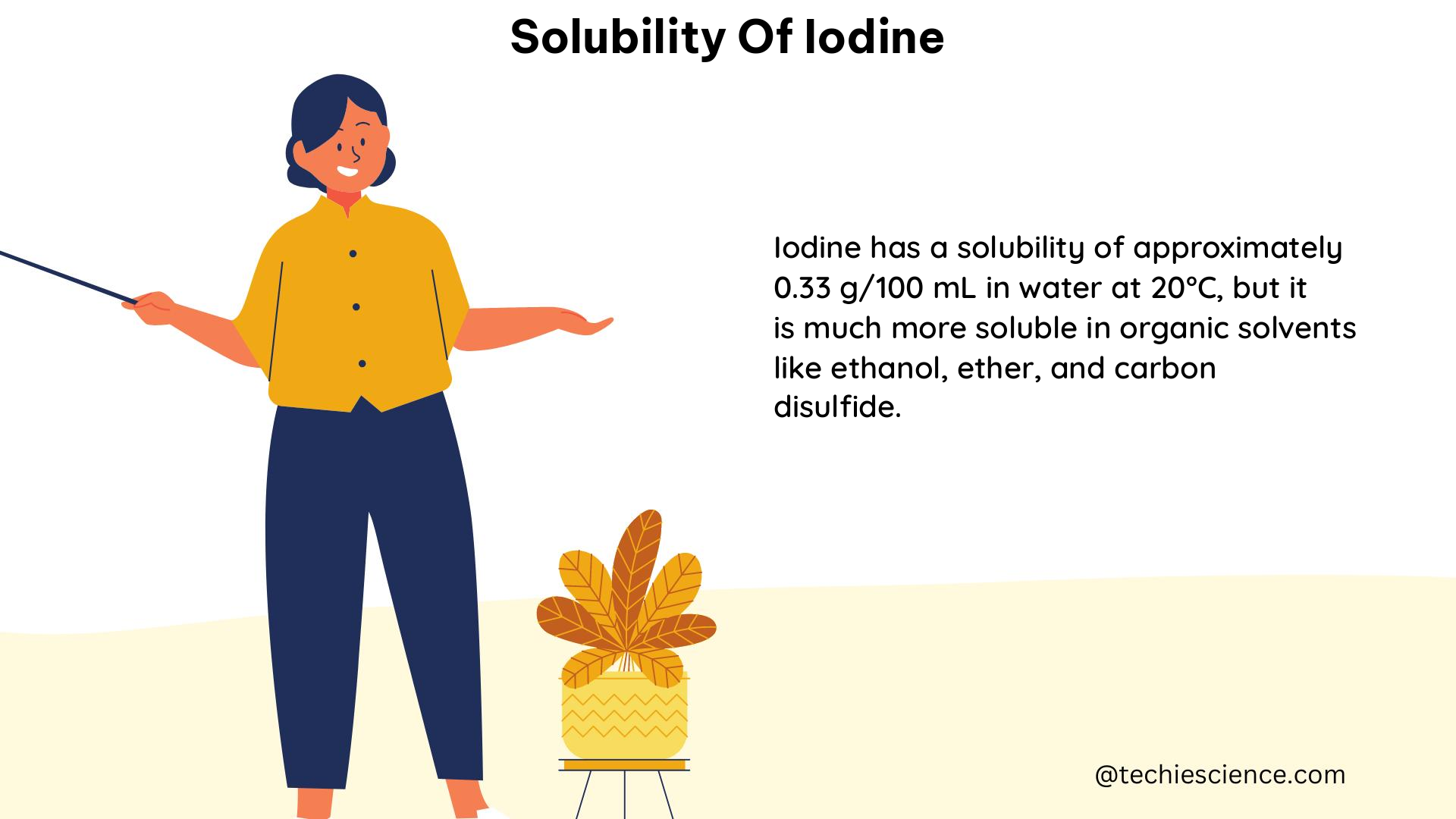Iodine, a versatile element with a wide range of applications, exhibits a fascinating solubility behavior that has been the subject of extensive research. From its low solubility in water to its remarkable solubility in nonpolar solvents, the solubility of iodine is a crucial factor in various fields, including chemistry, pharmaceuticals, and materials science.
Understanding the Solubility of Iodine in Water
Iodine has a very low solubility in water, with only 0.0162 g dissolving in 100 mL of water at 0°C. This low solubility can be attributed to the strong intermolecular forces between iodine molecules, which are primarily van der Waals forces. The nonpolar nature of iodine molecules makes it challenging for them to interact with the polar water molecules, resulting in the limited solubility in aqueous environments.
To quantify the solubility of iodine in water, researchers have employed various experimental techniques. One such method involves the use of distribution equilibria and solvent extraction techniques to determine the stability constant (Kst) of the tri-iodide ion (I3-). By calculating the distribution coefficient (KD) and distribution ratio (D), researchers were able to establish the Kst of the tri-iodide ion, providing valuable insights into the solubility behavior of iodine in water.
Iodine’s Remarkable Solubility in Nonpolar Solvents

In contrast to its low solubility in water, iodine exhibits a significantly higher solubility in nonpolar solvents, such as carbon tetrachloride and hexane. This enhanced solubility can be attributed to the strong intermolecular interactions between the nonpolar iodine molecules and the nonpolar solvent molecules.
The solubility of iodine in nonpolar solvents can be quantified using the following equation:
S = Ksp * [I2]
Where:
– S is the solubility of iodine in the nonpolar solvent
– Ksp is the solubility product constant
– [I2] is the concentration of iodine in the nonpolar solvent
By determining the Ksp value, researchers can accurately predict the solubility of iodine in various nonpolar solvents, which is crucial for applications such as the determination of the stability constant of the tri-iodide ion.
Complexation of Iodine with β-Cyclodextrin (β-CD)
In addition to the solubility behavior of iodine in water and nonpolar solvents, researchers have also investigated the formation of iodine complexes with other molecules, such as β-cyclodextrin (β-CD).
The formation of the iodine/β-CD complex has been studied using X-ray diffraction (XRD) analysis. The XRD spectra of the starting materials (iodine and β-CD), their stoichiometric mixture, and the resulting complex showed distinct differences and unique patterns, confirming the successful formation of the iodine/β-CD complex.
Table 1 in the study provides the results of the quantitation analysis for the iodine/β-CD complex. The data includes the peak height of iodide in the chromatograms, the amount of iodine species in the iodine/β-CD complex, and the relative standard deviation (RSD) for five samples. This information is crucial for understanding the composition and stability of the iodine/β-CD complex.
Reduction Yield of Iodine
Another important aspect of iodine’s solubility behavior is its reduction yield, which can be determined by titration with a reducing agent, such as thiosulfate solution.
Table 2 in the study presents the results of the reduction yield experiments. The volume of a 0.05 M iodine solution and the volume of the added 0.1 M thiosulfate solution were measured to calculate the reduction yield. This data provides valuable insights into the redox behavior of iodine and its potential applications in various chemical processes.
Practical Applications of Iodine’s Solubility Behavior
The understanding of iodine’s solubility behavior has numerous practical applications in various fields:
-
Chemistry: The solubility data and complexation studies of iodine can be used in analytical techniques, such as spectrophotometry and chromatography, for the quantitative determination of iodine and its compounds.
-
Pharmaceuticals: The solubility of iodine in nonpolar solvents and its ability to form complexes with molecules like β-CD can be exploited in the development of drug delivery systems and formulations.
-
Materials Science: The solubility and complexation properties of iodine can be utilized in the synthesis and characterization of novel materials, such as iodine-based polymers and composites.
-
Environmental Applications: The understanding of iodine’s solubility behavior is crucial in the context of environmental remediation, where the fate and transport of iodine in various media need to be considered.
-
Biological Systems: Iodine is an essential trace element for human health, and its solubility and bioavailability are important factors in the study of iodine metabolism and deficiency disorders.
Conclusion
The solubility of iodine is a complex and multifaceted phenomenon that has been extensively studied. From its low solubility in water to its remarkable solubility in nonpolar solvents, the understanding of iodine’s solubility behavior is crucial for a wide range of applications in chemistry, pharmaceuticals, materials science, and beyond. The quantitative data, experimental techniques, and theoretical models presented in this comprehensive exploration provide a valuable resource for researchers and practitioners working with this versatile element.
References
- Iodine Clock Challenge – Flinn Scientific
- Development of an Improved Method for the Determination of Iodine – NCBI
- Iodine clock reaction demonstration method – RSC Education
- Exp7.pdf – MTSU

The lambdageeks.com Core SME Team is a group of experienced subject matter experts from diverse scientific and technical fields including Physics, Chemistry, Technology,Electronics & Electrical Engineering, Automotive, Mechanical Engineering. Our team collaborates to create high-quality, well-researched articles on a wide range of science and technology topics for the lambdageeks.com website.
All Our Senior SME are having more than 7 Years of experience in the respective fields . They are either Working Industry Professionals or assocaited With different Universities. Refer Our Authors Page to get to know About our Core SMEs.